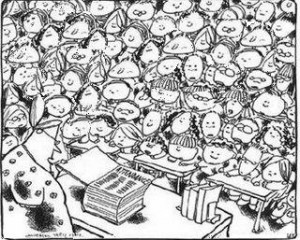 Budget cuts in education are causing school districts to reduce staff resulting in an increase of the number of students per classroom.
Budget cuts in education are causing school districts to reduce staff resulting in an increase of the number of students per classroom.
I have read various contradictory research studies which state class size matters, class size doesn’t matter, or it only matters to certain groups, such as the underprivileged. We do not need a ten-year longitudinal double-blind study to tell us what we already know.
Logic and classroom experience clearly dictate that class size matters; a teacher’s time can only be divided so much before it negatively affects learning in the classroom.
Many district officials do not recognize the problem with adding a few more kids to a class. However, this should be a serious concern. Usually the voices we hear speaking up against increasing class size are the parents who are worried their child will not get enough attention or we hear from the teachers who are worried they may be the one given the pink slip.
However, I am someone who does not have a dog in this fight, I am speaking up as an educator who is no longer in the classroom and no longer has a child in the public schools. I am speaking with 16 years of first-hand experience.
Size matters. I had varying numbers of students from year to year. The year my class size increased from 24 to 28 pupils, my students and I determined a four pupil increase significantly reduced learning in the classroom.
First, it was the dilution of teacher attention available to each child. The more pupils, the less personal attention devoted to each child by the teacher. This led to less feedback and reinforcement available to each student as they worked on classroom assignments. Less reinforcement and individual guidance by the teacher means less learning will occur.
Second, there is an observable psychological phenomenon which takes place when people (or rats) are crowded together. Children become more agitated, aggressive and distracted. Imagine being a child in a class with other kids just inches from you-on all four sides, day after day.
There is the kid in front of you pushing his chair into your desk every time he scoots back, behind you there is the girl who whistles when she breathes and then there are the kids on each side of you playing with the things in their desk and even worse, bothering you and the things on your desk.
The end product of crowded classrooms is like giving students an extra dose of “aggressiveness” or “distractibility”. Overcrowding classes can cause otherwise successful students to under perform and marginal students to fail completely, despite any extra efforts of the classroom teacher.
A kindergarten boy came home from his first day of school and his mother asked what he had learned. He replied, “My music teacher told us she has a bubble around her and we are not to penetrate her bubble.” The mother asked him what he thought the music teacher meant by that comment. The boy replied, “I think she doesn’t want kids in her space.” The boy thought for a second and then added, “I wish I had a bubble around me.”
Most of us can identify with this kindergartner.
Those of you who grew up in classroom of 30 students or more may wonder why we need smaller classes; we turned out fine, didn’t we? However, times were very different back in the “old days”. Special needs children were not integrated into the regular classroom and students were evaluated, placed and worked in groups at their level, such as reading groups. Also, unfortunately, discipline problems were not as much of an issue as they are today. Overall, the teacher had more time to help the students.
Many school districts justify increasing class size during budget crunches in the following manner. They will survey their faculty to find out their job priorities by allowing teachers to rank items like class size and teacher salary. Under this system the majority of teachers will rank salary higher. This is because they already feel undervalued and underpaid as the workloads increase.
However, if money was not a part of the survey and teachers were asked what could be done to improve the education children receive, most if not all would agree with lowering the class size.
Even though there are parental influences and biological/physical limitations upon children that teachers have limited influence over, give them a class size of 12 to 15 students and let them show you how they can improve motivation to learn, test scores, student behavior, self esteem and nearly every other factor that contributes to students becoming responsible and productive adults
Unfortunately, as budget cuts continue, classrooms will become further crowded. It appears the new policy will be for school districts to increase class size and then blame teachers for the deterioration in test scores. How can we profess a desire for equality and excellence in education, but announce cuts in the resources necessary to ensure those very goals?




Amen! I was really feeling this today in my class for 31 freshmen.